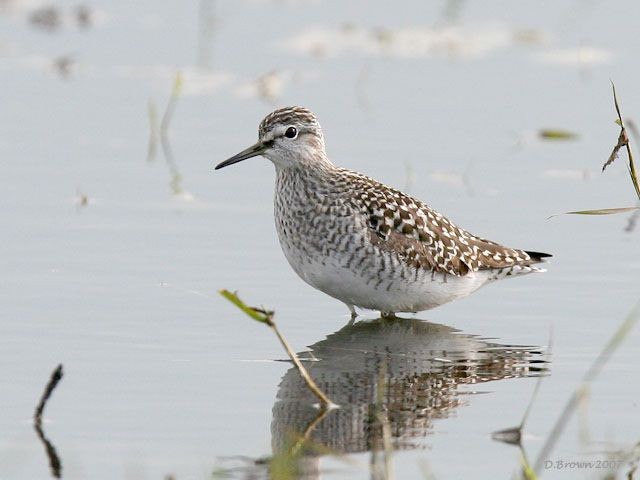
Wood Sandpiper: Northumbs, May. An attractive passage migrant, scarce in spring but more numerous in autumn. Movement to, and from, breeding and wintering areas takes place overland, largely to the east of the UK. The largest numbers occur in east-coast counties, especially East Anglia and the southeast. Spring passage takes place from late April to early June and returning birds can be noted from late July to mid-September (photo: David Brown).
Introduction
The late summer period can be a quiet one for birders awaiting the increased pace of the autumn. Inland watchers who have scoured their local wetlands during the spring find little other than breeding birds to steal their attention. The change in 'season' is quick though and the first sign of movement in these areas is usually the appearance of a 'bobbing' Green Sandpiper or two; their unobtrusive presence at the muddy margins often only betrayed when they take to the air with their clear ringing call, black wings and white rump. It is also during these periods that the much scarcer (in the UK) Wood Sandpiper may put in an appearance, often alongside their commoner relative allowing observers the opportunity to compare these two delightful waders.
European Distribution and Movements
With a European breeding population of between 330,000 and 800,000 pairs, the bulk of Green Sandpipers breed in Russia and Finland. The total European breeding population of Wood Sandpipers is estimated to be in the range 350,000-1,200,000 pairs, mostly in Russia, Finland and Sweden. A handful of pairs of Wood Sandpipers breed in Britain, but it is predominantly a passage migrant in spring and autumn. Green Sandpiper has only bred in Britain on a couple of occasions. The Green Sandpiper is a common passage migrant, particularly so during the autumn, and it also has a UK wintering population of less than 1,000 birds.
Wood Sandpipers winter across Africa, southeast Asia and Australia. Britain attracts a variable number of birds heading to or from their Scandinavian breeding grounds. Numbers vary from year to year and in some years birds can be relatively scarce, whilst in others with a favourable easterly airflow good numbers can be seen.
In 'autumn', the first Green Sandpipers tend to occur during mid-June, after which numbers build up through the rest of the autumn. The first arrivals are adults, presumably females, as the care of the young is the responsibility of the males. These birds are then supplemented by juveniles from late July onwards, with main passage taking place between July and August. In late summer and autumn, birds can be found in a wide variety of habitats from small puddles through to the muddy margins of large reservoirs. During the winter months there is a shift away from gravel pits and lagoons to areas with running water, though there is a strong degree of site fidelity with birds returning winter after winter. As a young birdwatcher growing up near York I used to watch a Green Sandpiper each winter in a small pig run near my home; the habitat was nothing more than sludge with several pigs for company, but this bird returned for at least six winters running.
Identification
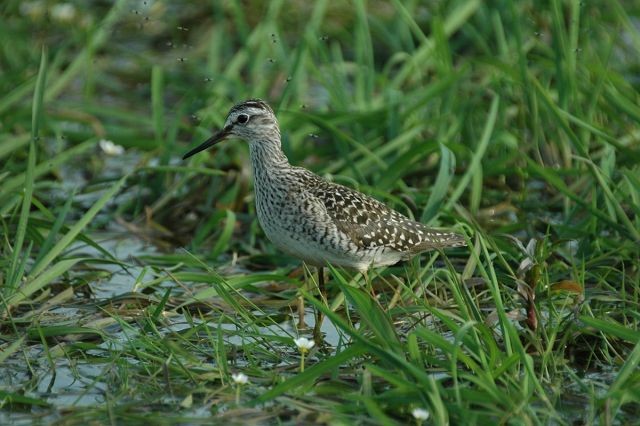
Wood Sandpiper: Poland, May. The boldly marked upperparts and obvious supercilium passing behind the eye are obvious pointers to a spring bird, as are the relatively long yellowish legs and marked breast and flanks (photo: Stuart Greer).
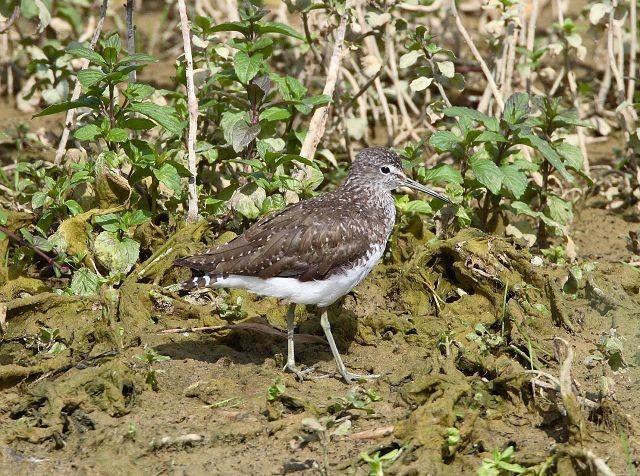
Green Sandpiper: Northants, July. Less striking than Wood Sandpiper, with shorter greyish-green legs. The upperparts are dark with faint mottling and the supercilium shorter, extending to above the eye. The underparts are cleaner than Wood Sandpiper, lacking the bars and stripes on the breast and flanks (photo: Neil Khandke).
 |
 |
| Green Sandpiper: Durham, April. In summer plumage Green Sandpipers are typically dark, with finely mottled upperparts. (Photo: David Brown) | Wood Sandpiper: Norfolk, May. In summer plumage Wood Sandpipers show boldly marked upperparts. (Photo: Alan Wadsworth) |  |  |
| Green Sandpiper: Lancs, June. The demarcation between breast and belly is quite obvious. (Photo: Sue Tranter) | Green Sandpiper: Manchester, Aug. Lacks a long supercilium, unlike Wood Sandpiper. (Photo: Sue Tranter) |
 |  |
| Wood Sandpiper: Northumbs, May. Appears elegant, especially so when alert. (Photo: Keith Reeder) | Wood Sandpiper: Hants, May . The legs are yellowish-green, rather than greenish-grey.(Photo: Russell Wynn) |
 |  |
| Wood Sandpiper: Kerry, Sept. Juvenile. The breast lacks the clean-cut demarcation shown by Green Sandpiper. (Photo: Mike O'Keefe) | Wood Sandpiper: Kerry, Sept. Juveniles are browner, with prominent pale spots on the upperparts. (Photo: Mike O'Keefe) |
Given good views, identification of either species is relatively straightforward. Apart from the risk of confusion with each other, Green Sandpipers might perhaps be confused with Common Sandpipers and Wood Sandpipers with juvenile Redshank, or perhaps some of the rarer visitors to our shores. However, all potential confusion species, and the differences between these two, are easily solved in flight.
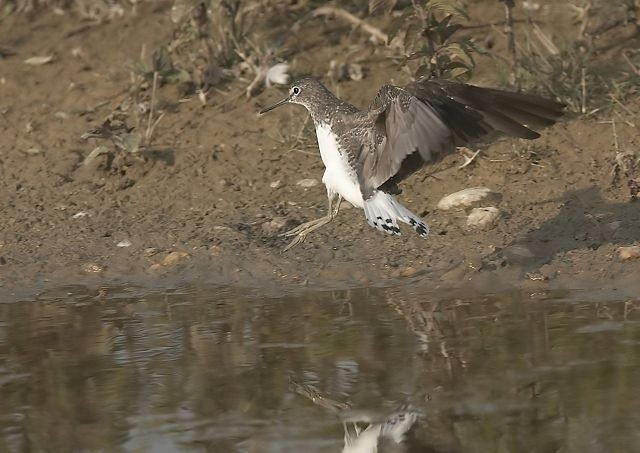
Green Sandpiper: Northants, July. In flight the blackish upper- and underwing contrast with the white rump, recalling, momentarily, a large low-flying House Martin. The tail bars are broad, unlike the narrow tail-bars of Wood Sandpiper. When flushed typically departs with the distinctive call (photo: Richard Bedford).
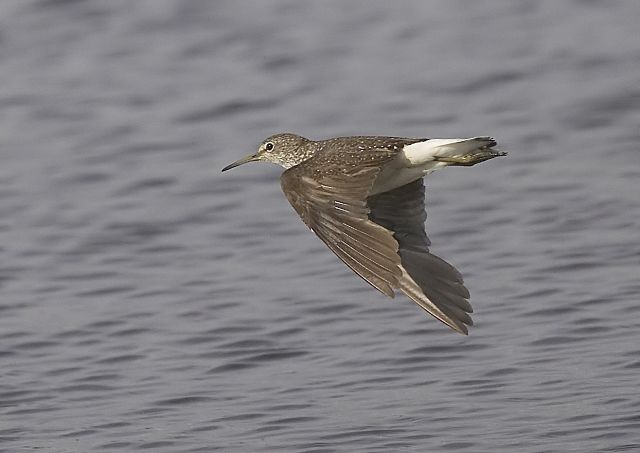
Green Sandpiper: Northants, July. In flight the toes hardly extend beyond the tail (photo: Richard Bedford).
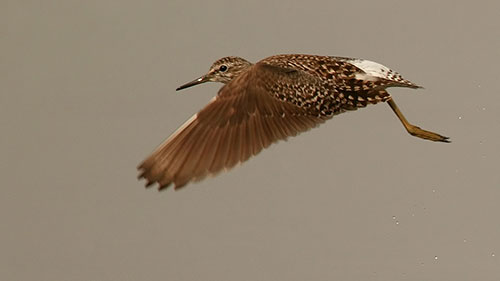
Wood Sandpiper: China, May. Note the toes projecting beyond the tail, plus the narrow tail bars. In addition the underwing is pale, and this elegant species lacks the contrast exhibited by Green Sandpiper. When flushed listen for the distinctive call, quite different from Green Sandpiper (photo: Available Light Images).
In flight, Green Sandpipers invariably call, a loud ringing 'tlweet-eet-eet'. As you look across the wetland area to get a fix on the calling wader you will see something that looks like a large House Martin, with a quick flicking flight, dark wings and a white rump. It is also in flight that you can see the underwing is entirely blackish. With closer flight views it is clear that the toes project very little beyond the tail.
In flight, Wood Sandpipers too will usually call, a dry high-pitched 'chiff-iff-iff'. Unlike Green Sandpipers there is not the same contrast, the underwings are pale and the toes project beyond the tail.
It is perhaps on the ground that many observers find it harder to separate the two. Green Sandpipers tend to be stockier than Wood Sandpiper, and are less elegant and shorter-legged. The upperparts are darker on Green Sandpiper, with fine speckles. From the front there is a clear-cut demarcation between the breast band and white underparts. On Wood Sandpiper the breast is 'washed out' and the upperparts have more obvious and defined markings. Turning attention to the head pattern, Green Sandpipers have a white-eye-ring and a supercilium that extends to just behind the eye. Wood Sandpiper on the other hand has a supercilium that extends behind the eye, giving them a 'capped' appearance.
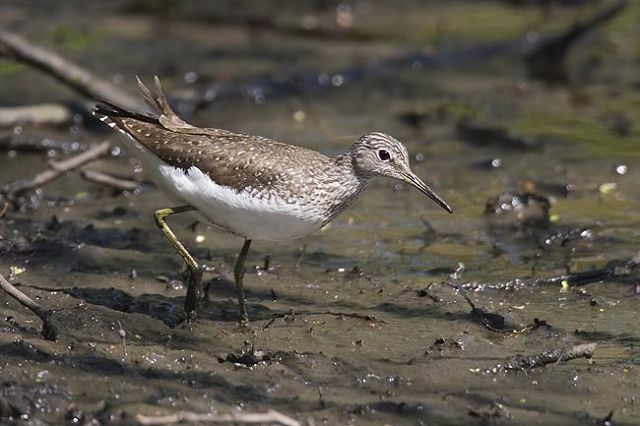
Green Sandpiper: Staffs, May. An attractive species, but darker and less eye-catching than Wood Sandpiper. Note differences in head pattern and underparts, plus duller legs (photo: Brian McGeough).
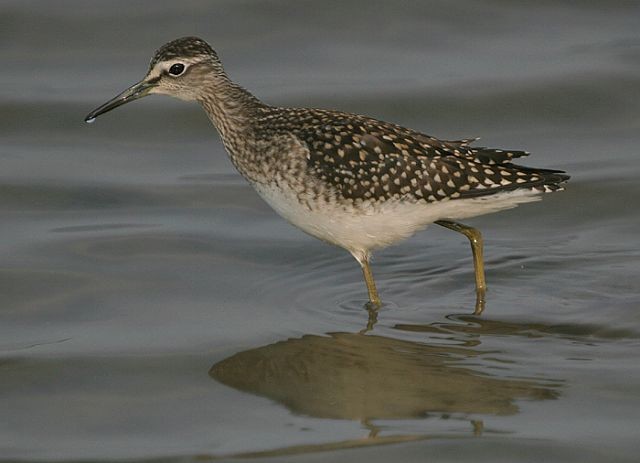
Wood Sandpiper: Norfolk, August. A striking species when seen well, perhaps inviting confusion with Lesser Yellowlegs with which it shares the squared-off rump and leg colour - there have been occasions when late autumn 'Wood Sandpipers' have avoided ID as the rarer Nearctic species. Differences to check for include the long primary projection of Lesser, plus the longer supercilium of Wood and its two-toned bill colour. In flight Lesser is far more rangy looking, but Wood Sandpiper remains a potential pitfall to be eliminated when faced with a possible Lesser Yellowlegs (photo: Will Bowell).

Wood Sandpiper: Spain, August. Juveniles have a finely streaked breast, with well spotted browner upperparts (photo: Steve Round).
At close range it may be possible to see the tail bars. On Green Sandpiper these are broad dark bars, whereas on Wood Sandpiper they are narrow. The legs of Green Sandpiper are greenish-grey, whereas on Wood Sandpiper they are yellowish-green.
 |  |
| Green Sandpiper: Warks, June. The tail bars are broad on Green Sandpiper. (Photo: Diane Harrison) | Wood Sandpiper: Norfolk, Aug. And narrow on Wood Sandpiper. (Photo: Will Bowell) |
Could it be a Solitary Sandpiper?
When looking through your local Green Sandpipers it is always worth considering the possibility of a Solitary Sandpiper. With over 30 British and Irish records, this exceptionally rare Nearctic wader would be a prize find for any local patch birder. Wintering in the Caribbean and South America, it is a rare transatlantic vagrant, but five were found between 2000 and 2005, including an inland bird. Although something of an Isles of Scilly speciality (there have been 12 records there), several records have occurred in southeast England, and no fewer than four have been found in land-locked Hertfordshire. It is probable that more go undetected as identification of a bird at rest is subtle; only in flight are they more easily separated from Green Sandpipers.
In flight the underwing is dark, as in Green Sandpiper, but the rump is dark with barred sides to the tail, unlike the black and white appearance of Green Sandpipers. Other flight differences, more easily appreciated when seen with Green Sandpipers, include longer, narrower, wings, and slighter build. On the ground the differences are less obvious. The rear of a Solitary Sandpiper looks more attenuated as the wing tips extend further beyond the tail. Plumage-wise, the upperparts have more spotting than a Green Sandpiper and the white eye-ring is more obvious than the eye-ring of a Green Sand. Similarly, the bill is longer and slightly decurved and the legs are also longer. These differences are perhaps better appreciated when one is seen in the company of Green Sandpipers.

Solitary Sandpiper: Scilly, November. At rest, features to look for on a potential vagrant include the bolder eye-ring, longer bill, attenuated rear and better marked upperparts (photo: Tristan Reid).
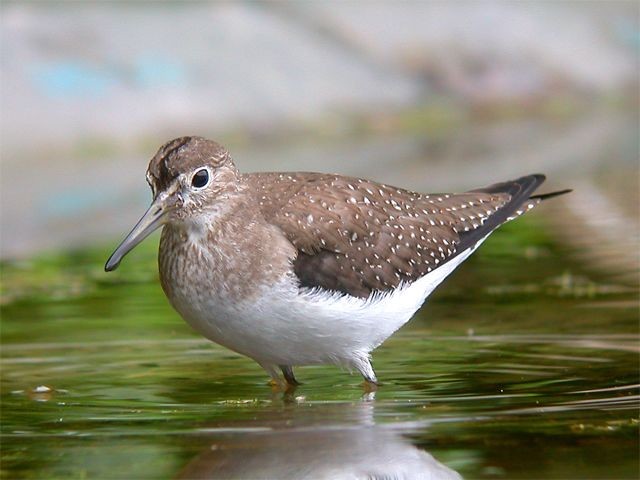
Solitary Sandpiper: Scilly, November. Note the attenuated rear due to the extended wingtips, plus slightly decurved bill (photo: David H. Hatton).
 |
 |
| Solitary Sandpiper: Lewis, Outer Hebrides 2003. Features that separate Solitary from Green Sandpiper include the bolder eye-ring, longer bill and better marked upperparts; on this shot the dark centre to the rump is also apparent. (Photo: Martin Scott) | Solitary Sandpiper: Lewis, Outer Hebrides 2003. Note the attenuated rear due to the extended wingtips. (Photo: Martin Scott) |




